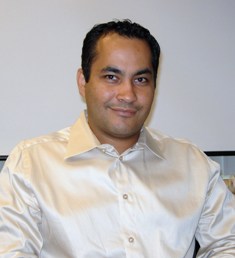Professor Ali Khademhosseini
The MIT Technology Review article Self-Assembling Tissues: Living Legos can be directed to form tissue-like structures said
“Tissue engineers are ambitious. If they had their way, a dialysis patient could receive a new kidney made in the lab from his own cells, instead of waiting for a donor organ that his immune system might reject. Likewise, a diabetic could, with grafts of lab-made pancreatic tissue, be given the ability to make insulin again. But tissue engineering has stalled in part because bioengineers haven’t been able to replicate the structural complexity of human tissues. Now researchers have taken an important first step toward building complex tissues from the bottom up by creating what they call living Legos. These building blocks, biofriendly gels of various shapes studded with cells, can self-assemble into complex structures resembling those found in tissues.‘Living tissues have repeating functional units,’ says Ali Khademhosseini, a bioengineer at Harvard Medical School. The liver, for example, is made up of repeated hexagonal lobes. Each has a central branching vessel that brings in blood for filtration; the vessel and its branches are surrounded by toxin-filtering cells surrounded by canals that transport filtered blood to other vessels leading out of the organ. Traditional approaches to tissue engineering, says Khademhosseini, ‘rely on the cells to self-assemble and re-create structures found in the body.’ Bioengineers seed cells onto the outside of polymer scaffolds in the hopes that they will migrate inside and organize themselves. Cells do self-organize to some extent, but such top-down attempts have had limited success.”
Ali Khademhosseini, MASc, PhD is Assistant Professor of Medicine and Health Sciences and Technology, Harvard Medical School, Brigham & Women’s Hospital. He is the winner of the MIT Technology Review TR35 Top Young Innovator Award 2007.
Despite significant advances in medicine and biology, the lack of precisely defined in vitro systems has hindered our ability to understand cell function and to regulate its behavior for tissue engineering. In addition, our inability to miniaturize experiments and to perform high-throughput cell-based experiments has limited our ability to define optimized culture conditions. Therefore, it is important to control cell microenvironment in a manner that is tightly controlled, reproducible, and scalable.
Using innovative approaches at the interface of biology, engineering, medicine, and materials science, he aims to address this challenge. His goal is to develop micro- and nanoengineering approaches for controlling cell microenvironment and to use these techniques to regulate stem cell fate decisions. To control cell microenvironment he develops novel micro- and nanoscale technologies to regulate cell-cell contact (using patterned co-cultures), cell-ECM interactions (using novel biomaterials), cell-soluble factor components (using microfluidics), and cell shape (using micropatterning).
In addition, he has developed microfluidic and microarray methods to perform high-throughput experiments, in order to facilitate systematic testing of various environmental conditions on cell fate. Equipped with these tools he studies various aspects of stem cell self-renewal and differentiation and develop microreactors that facilitate directed differentiation of stem cells to therapeutic cells.
Ali edited Micro- and Nanoengineering of the Cell Microenvironment, Technologies and Applications, and coauthored Microscale technologies for tissue engineering and biology, Nanoparticle-Aptamer Bioconjugates: A New Approach for Targeting Prostate Cancer Cells, Layer-by-layer deposition of hyaluronic acid and poly-l-lysine for patterned cell co-cultures, A simple soft lithographic route to fabrication of poly(ethylene glycol) microstructures for protein and cell patterning, Fabrication of gradient hydrogels using a microfluidics/photopolymerization process, Cell docking inside microwells within reversibly sealed microfluidic channels for fabricating multiphenotype cell arrays, Direct Patterning of Protein- and Cell-Resistant Polymeric Monolayers and Microstructures, and Molded polyethylene glycol microstructures for capturing cells within microfluidic channels.
Ali earned his BS in Chemical Engineering from the University of Toronto in 1999, his MASc in Chemical and Biomedical Engineering from the University of Toronto in 2001, and his PhD in Bioengineering at the Massachusetts Institute of Technology (MIT) in 2005. His patents include Controlled Release of a Curing Agent for the Generation of Microstructures and Amplification of cell populations from embryonic stem cells.
Watch A Microfluidic Device with Groove Patterns for Studying Cellular Behavior. Read Prof. Ali Khademhosseini: Building tissues, cell-by-cell.
